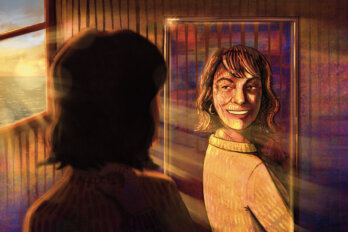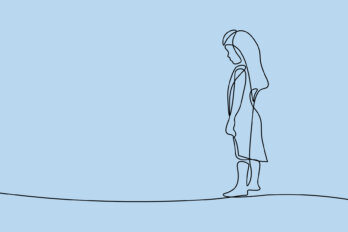Looking out from behind the screen that hides my story notes and dice, I wait for a decision. The group at the table—some of them fathers my own age, some their middle-school-aged kids—huddles together, discusses strategy. I’ve just described to them what their characters see in the cavernous room around the bend in the cave: goblins, a dark wizard, and an ogre. I’m here to run them through the basics of playing Dungeons and Dragons. I’m their “Dungeon Master,” they are my “Player Characters.” They found me, as we find everything now, through friends on Facebook.
The game itself is an exercise in shared storytelling. Sometimes it turns out dramatic and intense, other times it’s hilarious and intense. This is our third Sunday afternoon session, and the short adventure I’ve prepared in advance is coming to its climactic end. The object of their quest lies on a goblin-surrounded altar: a ruby that can summon terrible powers. Their task is to rescue it from the foul clutches of the wizard so further evil might not be summoned into our imaginary world.
As I describe the battle tactics of the bad guys, they tell me what their characters are doing. We all roll dice to see if each action is a success or failure. The fathers are playing halflings (like hobbits) and dwarves, while the kids are playing a hulking barbarian, a sly elven rogue, and a human martial-artist monk. Each player’s opinions and ideas are heard equally at the table. Do they rush in, swords and spells flashing, or do they sneak past, hoping to avoid detection?
The consensus this time is the same as the last: send the barbarian in first.
Back in grade nine, the woman who is now my wife probably wouldn’t have dated me. She was cool and pretty, on the track team, and in the journalism club. I was most assuredly not cool and had bright red hair, copious freckles, and big glasses straight out of Degrassi.
Yes, I was in a club, too, but it was the drama club. And Dungeons and Dragons. There were five or six of us that met at lunches and after school in the blessedly bully-free safety of abandoned English classrooms, forming desks into a (then illicit) circle. Occasionally, some jock would walk past the door and call us some foul name, but they dared not come in, in case someone saw them and started to think they’d gone nerd. We rolled dice, solved problems, and told stories to one another. On the weekends, we continued our “campaigns” at home, with folding chairs set up at a pool table in a basement (under threat from the host’s father that if we spilled pizza grease on the felt, no one would ever find our bodies.)
Never heard of Dungeons and Dragons? You must not have lived through the ’80s. The game garnered peak publicity when evangelical groups around the world cried Satanism, while nerds like me gathered to role-play knights, wizards, rogues, and barbarians. They called it “the Satanic panic.”
Of course, that was all nonsense. The stories told in D&D can be dark or light and can go on for years, depending on the will of the group. Epic lives are lived and lost. Entire generations can come and go within the game while only years pass without. One of the most popular games in history, D&D is now enjoying a worldwide renaissance. Stars such as Vin Diesel and Stephen Colbert play; rock bands such as Arcade Fire play; the game features on popular TV shows, including Community, The Big Bang Theory, and Stranger Things; YouTube is chockablock with live streams of semi-famous folk playing games in front of live audiences.
With the popularity of fantasy franchises like Harry Potter, The Lord of the Rings, and Game of Thrones, a new generation of kids are primed to enjoy this game. It’s suddenly cool to be a nerd. Who’d have guessed? Even weirder for those of us who were children of the ’80s, now parents are playing it. With their kids.
I started playing D&D when I was ten. My family had moved from rural Ontario to Brampton, and things were not going well. I spent a lot of time in my room reading books. I was bullied on the streets and at school. Graphically so. In 1981, you didn’t call the cops or notify the school about bullying; you either solved it yourself, by fighting back, or your dad went over to your bully’s house and kicked his dad’s ass. These things weren’t working for me: too many bullies to deal with and a dad who put in long hours at work. So I mostly developed my short-distance sprinting skills.
Then one day my father did solve things: he came back from a golf trip carrying a red box with rules and dice in it and said, “This looks like the sort of thing you’d like.” Little did he know. Suddenly I was a seven-foot-tall warrior who could punch the face off a troll. I was an arcane master who could harness ancient powers to consume my enemies with fire. I was a stealthy rogue who could blend effortlessly into the shadows and sneak attack when the moment was just right. I ventured fearlessly into dark forests and forbidden dungeons to battle goblins, orcs, ogres, and, yes, dragons. And I never had to leave my room.
I sidled up to the other nerds at school and told them about the game. We formed a group. We started staying in at lunch. I ran the sessions and they played the characters. I began creating a massive world with maps, political systems, multi-theist religions, unique races and powers, famous warriors and wizards. The maps themselves were so detailed that they went from continent down to kingdom down to city down to floor plans for individual buildings within a city. I filled notebooks with lists of gods and royalty and mythological history. I created a fantasy world I would work on for nearly ten years as my friends and I shielded ourselves from the real world and made our own. Where I had once been powerless, I was suddenly powerful.
While my dad, however unwittingly, introduced me to a pastime that would consume my nerdy teenage years and drive my hyper-Christian mother apoplectic, he certainly didn’t play with me. It was just a gift to give his nerdy kid who spent too much time reading indoors. He didn’t understand the game or care about it. But these dads I’m coaching have a different framework, a different set of fond memories. And they’re eager to pass them on.
I lost interest in fantasy in my late teens when my fantasies changed. I had discovered girls. Also: beer, parties, sex, and rock ’n’ roll. I went to, and dropped out of, theatre school. I got into poetry. I read literature. I travelled the world. I lived an interesting life without dice. I had fond memories of D&D, but I kept them hidden from my new artsy friends. There was something of a stain about the game, a sense that this “frivolous” past might make people take me less seriously.
Things changed a couple of years ago, when I turned forty-three. I was well past cool by any stretch of the imagination. My wife and I had a ridiculous spread of four children between us, ranging in age from six to sixteen. Try finding a Friday night movie everyone can agree on. So I said, “What about a game?”
And suddenly, I was back. I unboxed my archives of maps and notes, all of it carefully annotated in a fourteen-year-old’s attempt at calligraphic hand. Drawings, stories, rules, maps; it was all there, waiting. And to my surprise, everyone loved it. Even my wife. The former track star was now an elven assassin. In fairness, she played mostly out of love for everyone at the table, but she played and had a great time. We all did.
Why had I stayed away so long? It was ideal family time—everyone looked directly at each other over the table, eyes bright, describing their next move in detail, moving their miniature warriors around the grid map on the table, engaging with the story, building powerful avatars of good. No phones, no screens, no video games, no earbuds—just family talking and laughing for hours at a time.
We played like this until the teens got more teenish and the little ones became bigger ones, and soon, they all started playing D&D in groups with their own friends. Turns out D&D was no longer the game of pariahs and nerds. A generation of cool kids brought up on fantasy movies and novels saw nothing wrong or aberrant about role-playing. Gaming was just another activity they did with their friends, like going to parties or the movies.
As they drifted to these other games, our family game started to take a back seat to a variety of social obligations. I felt a little abandoned, I’m not going to lie. So I tried to up the ante by designing miniature set pieces for the characters to move around in.
I had an idea to build a miniature boat on which the characters would travel and battle sea creatures. I even thought of building little tentacles to come up out of the “water” of our dining table. I had no idea how to do this, so I apprehensively typed “how to build miniature boat for D&D” into Google. Right away, I found a guy named Jeremy in Winnipeg who had a whole YouTube channel dedicated to scenery building. And he had thousands of followers. My mind was blown. A whole video of exactly what I wanted. I broke my decades-old rule about not talking nerd in public and started to tell friends about it.
I discovered three kinds of people in my circle of friends: those who had never played but had always been intrigued, those who had never stopped playing, and those who had stopped but were totally ready to get back in.
These last ones were often artists, musicians, HR specialists, house painters, filmmakers, marketing managers. They were people who had taken years away from the game to build new stories and worlds ironically based on skills learned in the game—storytelling, conflict and co-operation, problem solving, and dramatic expression. Many of them now had families of their own and were eager to start playing with their kids like I did. A zeitgeist was afoot. We nerds, inheritors of the earth, were coming out of hiding.
As the family game died away, I admitted to these guys how much I missed playing; before long, we’d started our own game. We met weekly at a dining table—a step up from the pool table in the basement—drank beer instead of Coke, and have been playing ever since.
A whole night of human contact without a comments section. Divine. And I’m not hiding it anymore either. Why bother? My almost twenty-year-old daughter just gave me a Dungeons and Dragons shirt for Christmas. I often wear it out of the house. Without even the slightest fear of reprisal or ridicule.
Let’s be honest—is golf any more serious a pastime? I mean, look at them with their checkered pants and wee shoes. Is memorizing football or baseball stats any less obsessive? Those guys are huge nerds! They paint their faces on game days and argue in bars over obscure rules and regulations. Does riding around as a middle-aged guy in a Corvette or on a Harley make one look any less desperate to recapture some tiny piece of the excitement and potential felt in one’s youth? I rest my case.
A few weeks ago, I was tagged in a Facebook post by a friend. She’d seen a dad she knows asking for guidance on how to run D&D for his family. The latest edition of the rules has been drastically simplified from the tables and mathematical acrobatics of earlier editions, but it’s still a lot to take in all at once. This dad wanted to play with his kid, and he was looking for someone to show him the ropes. Other dads also expressed interest.
When no one seemed to be stepping in, I said I’d oblige: run them through a few games so they would get a sense of the rules and flow of the game. We’ve played the three Sundays since. The fathers have come each week with their kids, everyone eager and willing to play. I narrate the story but also discuss how the rules work; they take notes and read my handout sheets and take actions that advance the plot or turn it in a new direction. The kids and dads work together to create an awesome memory. It’s like a practicum in cool dadding.
You’re probably wondering: Did they get the ruby? Is the world safe? Was evil vanquished? Turns out sending the barbarian in first is a winning strategy. The hero of the game is a slender, quiet twelve-year-old boy named Corbin in real life—Grog (a.k.a. “Muscles”) for three hours on a Sunday afternoon. He ran in and distracted the ogre while his teammates went for the ruby. Tomorrow, he heads back to school to learn how to navigate the social fabric of society without violence or any real physical danger. But for today, he’s a heavily muscled barbarian with a massive sword and the adulation of his friends as he rolls a twenty to strike the ogre down.
So ends the first part of the adventure and my time with the group. We wrap up the story to this point and count the mysteries left to solve. Where was this ruby from? What powers does it possess? What was the evil sorcerer trying to do with it? All fodder for future games. While D&D games can go on for years, this is the end of the road for my introductory “course.” I’m handing the reins over to one of the new dads to continue. I sort of hope they keep me up to date on what’s happening. I want to find out how the story ends.
Or how it keeps going.





